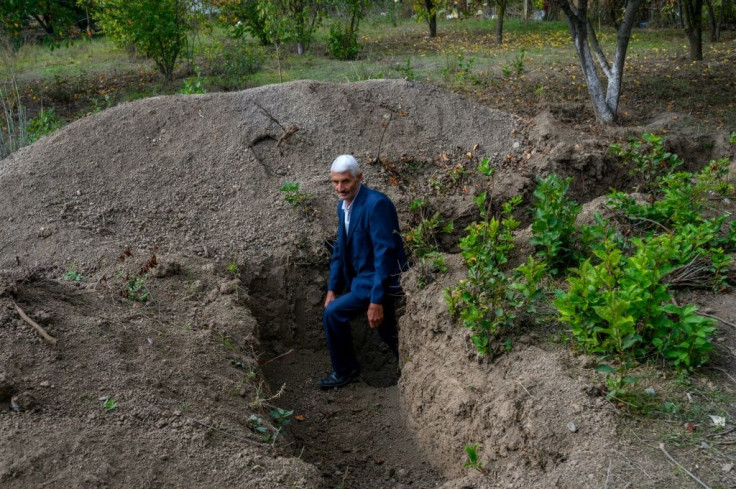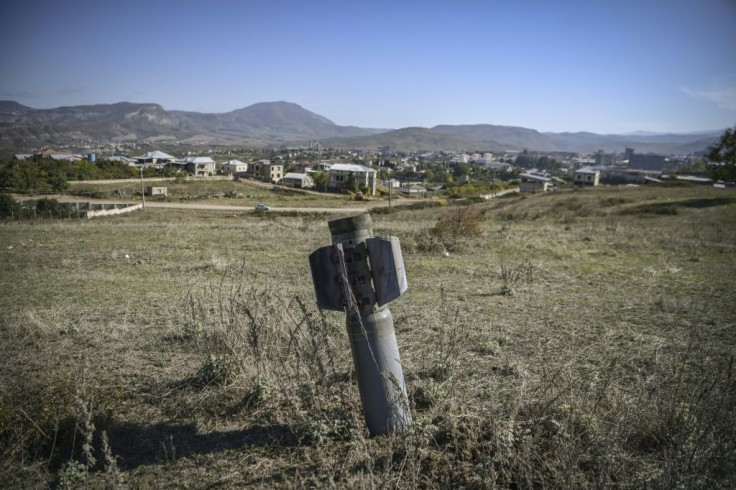'Basic Safety': Trenches Stretch Along Karabakh Front
Bayran Khalilov knew trouble was brewing when Azerbaijani government men came to dig trenches in his backyard facing the mountains of Nagorno-Karabakh.
The grizzled veteran of the original Karabakh conflict between ethnic Armenians and Azerbaijanis that killed 30,000 in the 1990s knew the shells were about to start falling again.
"These men came about one or two months ago and started digging," he said in front of an L-shaped trench as wide as his narrow frame and deep enough to cover him standing.
"They said it was for your own basic safety," the 68-year-old told an AFP team that was granted access to frontline areas by the Azerbaijani government.

"But we all then knew something was about to start."
The origins of a flareup in fighting over Nagorno-Karabakh that has now killed hundreds and threatens to involve regional powers Turkey and Russia are hotly contested and difficult to independently verify.
Both sides accuse the other of striking first on September 27 over the ethnic Armenian region of Azerbaijan.
Khalilov's account suggests that at least some in Azerbaijan's border regions were preparing for heavy fighting weeks before it broke out.

But none of the people AFP spoke to in the frontier village of Bakharly knew what prompted Azerbaijani officials to start preparing trenches along the front.
"We are very grateful they did," Khalilov said.
The shelling is all around Bakharly.

The dusty settlement at the foot of the Caucasus mountains once housed 800 families displaced by decades of strife.
Only about 100 men remain in Bakharly today.
Many who have stayed struggle to find the right words to explain what keeps them in the settlement under the shells.
"Why we are here -- that is the most important question," Sakhib Askerov said after showing off the trench dug behind his simple wooden house.

"Our boys are up there fighting," he said of the mountains.
"By staying here, we feel that we are also fighting, holding on to our land," the 66-year-old said.
Bakharly represents the outer reaches of Azerbaijani control in the central section of the conflict zone.
The fields beyond it are part of a no-man's land of the informal front.
Mikhail Ismailov walks two kilometres (one mile) along these fields daily to buy a few flatbreads he carries back home in a plastic bag.
He said the village endures "countless" bouts of shelling each night.
"This morning, they shelled our soldiers. Luckily they survived, with God's help. I always watch our soldiers from here," he said from his backyard.
"Every evening, we sit here and watch the fighting, first the shells coming from the Armenian side and then those going out from our side."
Armenian forces insist that they only return fire and otherwise try to respect a humanitarian ceasefire struck in Moscow on Saturday.
But the fighting along the front is omnipresent and becomes especially fierce at night.
"Every evening when the shelling starts, we come here to stay safe, so that we don't die," Ismailov said while showing AFP the inside of his trench.
"There is no fear. Our soldiers are fighting over there -- why should I be scared here. We shouldn't be scared."
But fellow villager Akif Kasymov said some of the men do leave when the fighting gets too heavy.
Many of the houses along his gravel road stand with their roofs sheered off completely and their walls caved in.
Some of the more intact homes still have unfinished meals left on tables -- telltale signs of families fleeing from sudden attacks.
"If it's not heavy shelling, we stay," said Kasymov. "We stay as long as we can."
© Copyright AFP {{Year}}. All rights reserved.





















